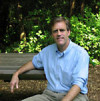Kip Ault
What brought you to Lewis & Clark? The opportunity to create and launch new master’s-level degree programs for people entering teaching (elementary and science).

Professor of Education
Years of Service: 24
What brought you to Lewis & Clark? The opportunity to create and launch new master’s-level degree programs for people entering teaching (elementary and science).
What course have you most enjoyed teaching and why? It’s a tie: “Ecoscapes” and “Field Geology for Teachers.” Both feature field study; “Ecoscapes” has examined how people have inhabit landscapes and focused on the Lower Columbia, the Tualatin Valley, Oregon’s High Desert, and Costa Rica’s Osa Peninsula. “Field Geology” has introduced novice learners to geologic inquiry in some of Oregon’s most fascinating places.
What is the most significant change you’ve seen at L&C during your time here? Establishment of the Graduate School of Education and Counseling as an independent, thriving, robust member of the Lewis & Clark community.
Can you describe an experience with a student that affirmed your love of teaching or passion for research? After teaching for more than two decades in Hawaii, a former student returned to Oregon, looking for work. She stopped by my office and shared, among many stories, how she had used knowledge gained in “Field Geology of Oregon” throughout her teaching career. One example was the “popcorn clock”–an analogy between the unpredictability of kernal popping to radiometric decay and the derivation of half-life. My research interests began with attention to children’s understandings of how geologists use time and led, during the past few years, to my role as a consultant to the “Trail of Time” project at the Grand Canyon. It’s very rewarding to find people (especially my students) valuing some of my notions for teaching geologic time.
Describe the most memorable moment of your time at Lewis & Clark. Chris Hedeen MAT ’00 (and now a teacher at Oregon City High School) spotted a fossil rhino tibia while hiking a trail in Blue Basin, north-central Oregon, during a Field Geology class. The Park Service put it on display and credited Chris.
What is something that others would find surprising about you? Some day I hope to learn to play my hammered dulcimer, which I built (with help) from a kit the same year I bought my first personal computer. The computer stole my attention away from the dulcimer; perhaps retirement will rectify this injustice.
What is your favorite place on campus and why? The courtyard near Fir Acres Theatre–because of the Magnolia trees; alas, many of which are gone.
What will you miss most about coming here every day? The view from my office window (4th floor, Rogers Hall) and greeting the staff and faculty when coming and going.
What accomplishments are you most proud of? The growth and reputation of our Science MAT, with well-balanced components in laboratory learning, field science, science pedagogy–coupled to our excellent apprenticeship model and professional coursework in education. My philosophical triad of publications: “The Necessity of Ambiguity,” “Achieving Querencia,” and “The Footprints Puzzle.” Immersing dozens of Oregon teachers in Costa Rican family life as well as the study of Costa Rican natural history for nearly 15 years, then hosting Costa Ricans in Oregon as participants in my Field Geology and Ecoscapes experiences. This exchange began with my 1993-94 sabbatical (and required me to become proficient in Spanish). Finally, my “Science and Children” class for new elementary teachers, which each year seems to rekindle not only their but also my childlike curiosity and fascination with the astonishing workings of the natural world.
What’s next for you? What are you looking forward to doing? I need to consolidate a number of essays and insights gained from my teaching into a book titled Serious Whimsy. It stresses the importance of imagery and story to learning science–a course correction, in my judgment, to the characterization of science as process. I do hope to work with informal science educators and park interpreters on making science inviting, accessible, useful, and authentic to wide audiences. Finally, I intend to work carefully with my Costa Rican friends from San Ysidro de Heredia on the development of a public Environmental Science School, /Bosque del Ture-Hua/, on the edge of Braulio Carrillo National Park.
More L&C Magazine Stories
Lewis & Clark Magazine is located in McAfee on the Undergraduate Campus.
MSC: 19
email magazine@lclark.edu
voice 503-768-7970
fax 503-768-7969
The L&C Magazine staff welcomes letters and emails from readers about topics covered in the magazine. Correspondence must include your name and location and may be edited.
Lewis & Clark Magazine
Lewis & Clark
615 S. Palatine Hill Road MSC 19
Portland OR 97219

